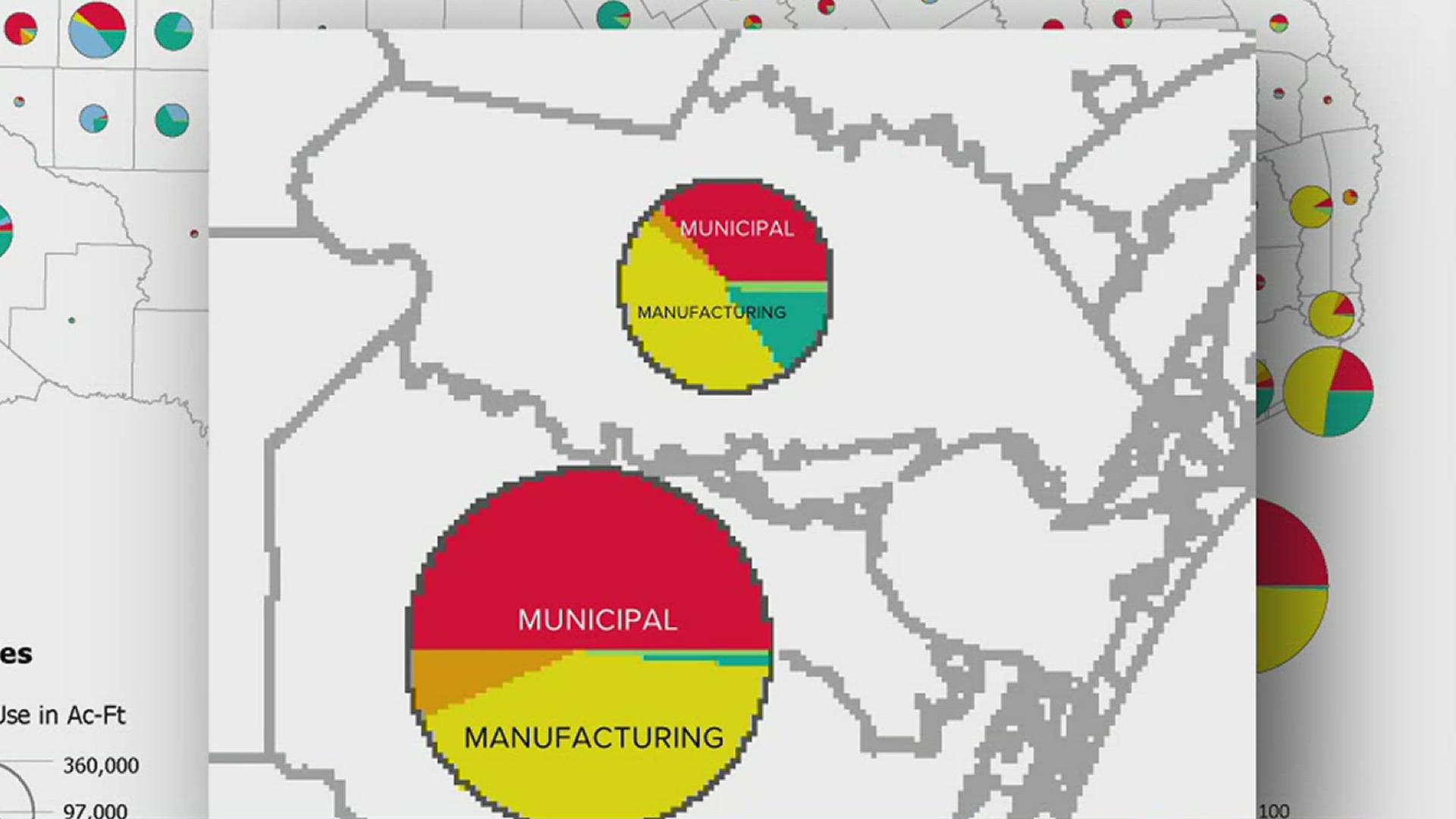CORPUS CHRISTI, Texas — The combined level for Corpus Christi's two main water sources, Lake Corpus Christi and Choke Canyon Reservoir, currently is around 27 percent.
And that's continuing to drop.
City leaders tell 3NEWS there are two parts to the problem: the weather, and the amount of local water consumption.
There are about 500,000 people and businesses across the Coastal Bend who depend on Corpus Christi's water supply.
Roughly, our area consumes 85 million gallons of water every day, but our consumption looks very different from other parts of Texas. For example, farther west, water is used for irrigation. In the middle of the state, the biggest percentage of water usage is residential use.
Whether we are brushing our teeth or taking a shower, it's estimated the average American family uses more than 300 gallons of water a day.
As the population in Texas booms -- adding 1.3 million people to its neighborhoods since the 2020 census -- it's natural to assume it has boomed in Corpus Christi, too.
Only, it hasn't.
So why is our supply treading water?
"There is more demand on our system than there was 4, 5 years ago," said Corpus Christi Water Chief Operating Officer Drew Molly.
But in Corpus Christi, residential use dropped by one million gallons a day from 2022 to 2023, said Texas A&M Corpus Christi Hydrogeology associate professor Dorina Murgulet.
"Our demand, per capita, is going down, so we really, obviously -- the residential use doesn't seem like it's impacting," she said. "We were here in 2019, but we have been going down since then, so this part of the pie should be shrinking, but we're growing in another area of the pie."
That slice: industry, and Texas Water Development Board data from 2021 paints a clear picture where that water goes.
The make-up of who uses our water is vastly different in Nueces and San Patricio counties, and sets this area apart from the rest of the state.
Corpus Christi Water distributes water to seven Coastal Bend counties.
"It's not a surprise -- We have a large industrial user group that uses a lot of water," said Molly, the COO. "And you know that that group uses you know, more than 50 percent -- a little more -- more than 50 percent of the water. And, you know, that same user group is part of the community."
Since the TWDB data was released, the Nueces and San Patricio counties have added even more industry.
"We are somewhat unique in our makeup that we're heavier on the industrial side than most areas," said San Patricio Municipal Water District General Manager Brian Williams.
He said with more industry comes more demand for water.
"About 50 percent is going to industrial customers and about 50 percent to municipal customers," he said.
Williams said the district primarily treats raw water it buys from the city of Corpus Christi.
"We also take some treated water from the city of Corpus, and most of that is going to Gulf Coast Growth Ventures," he said.
Industrial-size water needs
Gulf Coast Growth Ventures, located in Gregory, began operations in 2022 and joined an already large list of industry water consumers.
It needs 12.5 million gallons a day to operate, combining with Valero to account for 25 percent of the area's daily water use.
"Water is really the key enabler to our manufacturing process," said utilities and energy coordinator Jaclyn Curry. "It is in some of our final products as well as a key medium to even producing any of this."
GCGV employs 600 workers and produces plastics that are turned into everyday items like packaging, containers, and even shirts.
It's Curry's job to monitors imports of energy products and utilities, including water for the plant.
She said it's not just residents and local utilities providers who are keeping a close eye on the water levels as they continue to fall.
"There is concern, just like everybody else watching that level go down," she said. "We want the rain and we want a drought-resistant option, so we're thankful the city continues to investigate options."
Curry said the company's projected water use was supposed to be higher, but its consumption has fallen, thanks to conservation.
"Really, it's our operations that -- in diligence on watching that -- that's able to make that possible," she said.
The plant is also following the same watering restrictions residents do, and is taking part in a rain-barrel program for its employees.
So far, industry and large-volume consumption have not been impacted.
But that could change if we move to Stage 3 water restrictions.
Unfamiliar waters
"We know that everybody knows that the large-volume users: our refineries, our plastics-production plants -- who we respect and who we appreciate being here -- that part of our city," said Corpus Christi city manager Peter Zanoni. "We would look to them to see some type of savings in the water."
Under the drought management plan, the city could enact a surcharge for industry.
"If that long-term forecast is looking bleak, and if our water continues to decline, we have to do something," Zanoni said.
When Gulf Coast Growth Ventures first came to the area, it entered into a contract with the city of Corpus Christi to buy a certain amount of water.
After realizing it doesn't use all the water it buys, the company appeared at Tuesday's regularly scheduled Corpus Christi City Council, asking to be allowed to return 15 percent of that water to the city.
That's a reduction of almost 2 million gallons of water a day.
Council approved that amendment.
Valero provided this statement to 3NEWS:
"Water management is a critical component of our business, and we continue to work with stakeholders to improve our performance while reducing consumption in various ways, including recycling and reusing the water used in our operations. Valero Corpus Christi Refineries is also complying with Stage 2 water restrictions."

